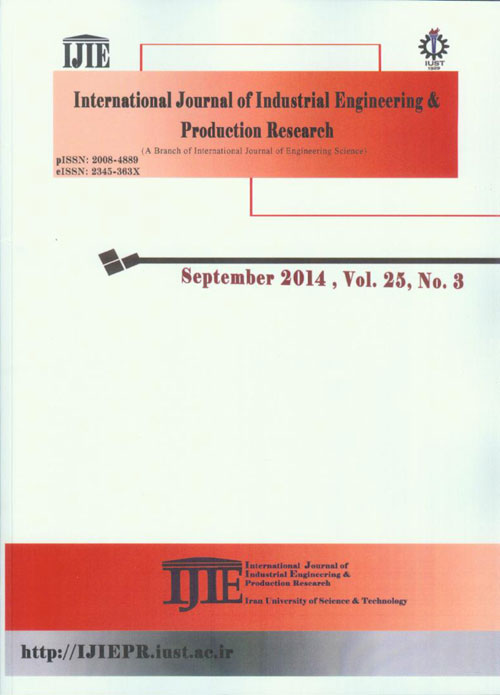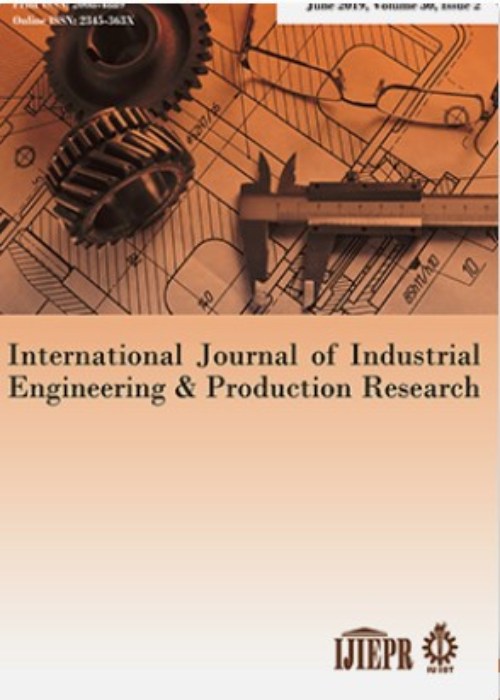فهرست مطالب

International Journal of Industrial Engineering and Productional Research
Volume:25 Issue: 3, Sep 2014
- تاریخ انتشار: 1393/05/25
- تعداد عناوین: 7
-
-
Pages 191-196The manufacturing organizations today are having a competition of supply chain versus supply chain. Existing research work fails to relate human metrics with supply chain performance. The authors intend to empirically assess the effects of human metrics on supply chain performance in the context of Indian manufacturing organizations. A rigorous literature review has identified 12 variables. The variables are individually measured and later on reduced in number by factor analysis. As a pilot study, primary data is collected from 100 manufacturing organizations by means of a questionnaire, both offline and online, which is administered across India and a scale is developed. t-test and factor analysis resulted in 3 factors related to human metrics. The outcomes of the research work provide valuable implications for the Indian manufacturing organizations to understand the factors affecting supply chain performance.Keywords: Supply Chain Management, Supply Chain performance, Human Metrics, Manufacturing
-
Pages 197-206Data mining is a powerful tool for firms to extract knowledge from their customers’ transaction data. One of the useful applications of data mining is segmentation. Segmentation is an effective tool for managers to make right marketing strategies for right customer segments. In this study we have segmented retailers of a hygienic manufacture. Nowadays all manufactures do understand that for staying in the competitive market, they should set up an effective relationship with their retailers. We have proposed a LRFMP (relationship Length, Recency, Frequency, Monetary, and Potential) model for retailer segmentation. Ten retailer clusters have been obtained by applying K-means algorithm with K-optimum according Davies-Bouldin index on LRFMP variables. We have analyzed obtained clusters by weighted sum of LRFMP values, which the weight of each variable calculated by Analytic Hierarchy Process (AHP) technique. In addition we have analyzed each cluster in order to formulate segment-specific marketing actions for retailers. The results of this research can help marketing managers to gain deep insights about retailers.Keywords: Market segmentation, Customer Lifetime Value (CLV), LRFMP model, Analytic Hierarchy Process (AHP), Clustering, Cluster analysis
-
Pages 207-214Data envelopment analysis operates as a tool for appraising the relative efficiency of a set of homogenous decision making units. This methodology is applied widely in different contexts. Regarding to its logic, DEA allows each DMU to take its optimal weight in comparison with other DMUs while a similar condition is considered for other units. This feature is a bilabial characteristic which optimizes the performance of units in one hand. This flexibility on the other hand threats the comparability of different units because different weighting schemes are used for different DMUs. This paper proposes a unified model for determination of a common set of weights to calculate DMUs efficiency. This model is developed based on a multi objective fractional linear programming model that considers the original DEA's results as ideal solution and seeks a set of common weights that rank the DMUs and increase the model's discrimination power. Comparison of the proposed method with some of the previously presented models has shown its advantages as a DMUs ranking model.Keywords: DEA, Common Set of Weights, Multi Objective Fractional Linear Programming, Membership Function, Ranking
-
Pages 215-224In this paper, a new approach based on game theory has been proposed to multi responses problem optimization. Game theory is a useful tool for decision making in the conflict of interests between intelligent players in order to select the best joint strategy for them through selecting the best joint desirability. Present research uses the game theory approach via definition of each response as each player and factors as strategies of each player. This approach cans determine the best predictor factor sets in order to obtain the best joint desirability of responses. For this aim, the signal to noise ratio(SN) index for each response have been calculated with considering the joint values of strategies; then obtained SN ratios for each strategy is modeled in the game theory table. Finally, using Nash Equilibrium method, the best strategy which is the best values of predictor factors is determined. A real case and a numerical example are given to show the efficiency of the proposed method. In addition, the performance of the proposed method is compared with the VIKOR method.Keywords: Game theory, multi responses, signal to noise ratio, Nash equilibrium, VIKOR
-
Pages 231-225In this paper, we develop a freight transportation model for railway network considering hazmat transportation issue. In the transportation system considered, different customers can request for carrying hazmat and non- hazmat boxes. It is assumed that the sequence of the trains in the network is known. The objective is assigning the non-hazmat boxes and hazmat boxes to wagons of the trains so that the transportation becomes safer. A zero-one integer programming model is presented that minimizes the cost of safe transportation. The model is solved using a new fuzzy approach.Keywords: Railway transportation, hazardous material transportation, freight transportation
-
Pages 233-242It is the purpose of this article to introduce a linear approximation technique for solving a fractional chance constrained programming (CC) problem. For this purpose, a fuzzy goal programming model of the equivalent deterministic form of the fractional chance constrained programming is provided and then the process of defuzzification and linearization of the problem is started. A sample problem is presented for clarification purposes.Keywords: Nonlinear Programming, Chance Constrained Programming, Linear Approximation, Fuzzy Goal Programming, Optimization
-
Pages 243-255The paper is devoted to solution of some problems in nuclear power station generating unit intellectual control systems using genetic algorithms on the basis of control system model development, optimizations methods of their direct quality indices and improved integral quadratic estimates. Some mathematical vector models were obtained for control system multicriterion quality indices with due consideration of stability and quality indices criteria, this increasing the reliability of optimal control system synthesis. Optimal control systems with fuzzy controllers were synthesized for nuclear reactor, steam generator and steam turbine, thus allowing comparison between fuzzy controllers and traditional PID controllers. Mathematical models built for nuclear power station generating unit control systems, including nuclear reactor, steam generator, steam turbine and their control systems interacting under normal operational modes, which permitted to perform parametrical synthesis of system and to study various power unit control laws. On the basis of power unit control system models controllers were synthesized for normal operational modes.Keywords: Control, Genetic algorithms, Multiple criteria analysis, Nuclear power station generating unit, Parametric synthesis, Quality indices


